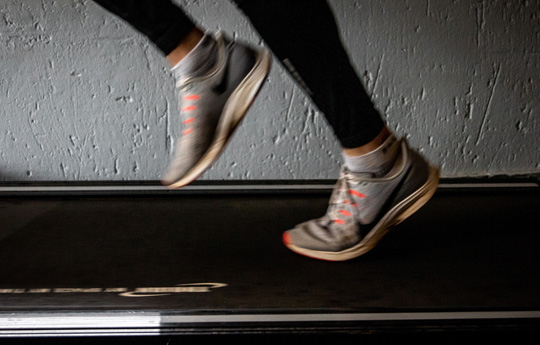Preventing Type II Diabetes with High Intensity Exercise
A new research project across Aberystwyth University and GP practices aims to develop practical recommendations on how High Intensity Interval Training can most effectively control blood sugar levels and help reverse diagnoses of pre-diabetes.
Cerin Brain, Rhys Thatcher & Rhi Willmot
Type II diabetes causes blood sugar levels to become excessively high. This can result in serious eye, heart and nerve problems, increased risk of amputation, and potentially even increase the severity and spread of COVID-19.
However, the onset of diabetes is often preceded with a warning. ‘Pre-diabetes’ refers to a condition in which blood sugar levels are elevated, but not high enough to be classified as diabetic. It’s possible to reverse this diagnosis by changing one’s physical activity and diet. This is important, as once a person is diagnosed as diabetic they must manage their condition much more stringently in order to avoid further health complications.
In fact, those who reverse their pre-diabetic diagnosis can largely resume a normal routine, whilst remaining conscious of living healthily. On the other hand, those who go on to develop diabetes will carry with this diagnosis, and the need to manage its consequences, for life.
Whilst many of us know that regular exercise will help control our weight and blood sugar, we also struggle to become more physically active. The most commonly reported reasons for this are a lack of time, and keeping up an exercise routine that has no supervision or structure.
However, an answer to this issue may come in the form of High-Intensity Interval Training or HIIT. HIIT has grown increasingly popular in the past several years, and involves alternating repeated bouts of vigorous exercise with periods of low intensity exercise or rest, for example in running, cycling or body-weight exercises.
Research has shown HIIT can improve blood sugar control more effectively and in a shorter time period than traditional, constant pace exercise. HIIT routines can also be carried out in a variety of locations with little or no equipment, and are easier to fit into a busy routine due to their relatively short duration.
HIIT could therefore provide a welcome solution for pre-diabetics who struggle to exercise amongst a busy lifestyle. However, little is known about how hard we should be working, and for how long, when carrying out a HIIT routine.
The Research
A new research study carried out by Cerin Brain and overseen by Dr Rhys Thatcher at Aberystwyth University has been commissioned to find out more. Cerin and Rhys work with GP surgeries to help patients diagnosed with pre-diabetes undertake different forms of HIIT. Here, the ultimate goal is to develop guidelines on which HIIT works best for blood sugar control.
Patients attend six HIIT sessions over the course of the project, after details of health and baseline fitness are taken. These sessions are carried out at various levels of intensity, and patients’ blood sugar levels are measured for 48 hours following each session using a sensor patch. Patients also choose from a menu of specific foods before, during and after their HIIT session, to control for the effects of diet.
Rhys summarises the research here: “High Intensity Interval Training (HIIT) has been used by athletes for many years to improve performance, but more recently it has been used in rehabilitation programmes for people with chronic medical conditions including diabetes and cardiovascular disease. While the use of HIIT is becoming widely accepted, there is uncertainty about the optimal programme design to improve blood glucose control for those at risk of developing diabetes. The current study addresses one of the key factors when designing a HIIT programme - the intensity of the high intensity bouts of activity. We hope that this will inform HIIT programme design and future recommendations for the use of HIIT to improve blood glucose control.”
The intensity of HIIT sessions is measured in multiple ways, including a patient’s heart rate. This means that exercise programmes can be customised to a person’s individual fitness level and that they can work out whether they are exercising at the optimal intensity at home by using a smartwatch.
The project also includes expertise from Aberystwyth Computer Science department, who have developed a programme to analyse data from the blood sugar readings. The partnership between the university and GP surgeries has been widely successful. Cerin said “Working with the two surgeries (Borth and Church) in Aberystwyth has been extremely beneficial to the study. Not only have the GP surgeries been welcoming and enthusiastic in their approach at being involved in the study, they have also offered first-hand information about different aspects of working with and treating the prediabetic patients.”
Future work will also explore the optimal duration and frequency of HIIT. The findings of this research will be used to develop practical recommendations for use in GP surgeries and pre-diabetes information packs, to help those diagnosed with pre-diabetes successfully and effectively reverse their diagnosis.
So, conducting research on exactly how hard to HIIT it can help us become physically active in a way that fits our lifestyle, and contributes to happy, healthy and full future.



